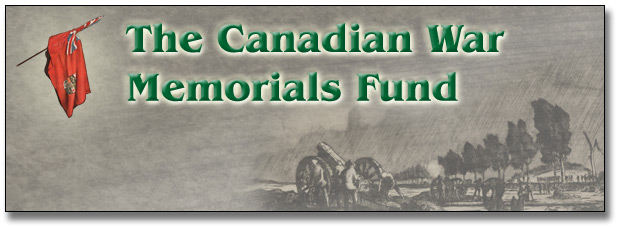
Sir Max Aitken (who would become Lord Beaverbrook), a 39 year old Canadian had been serving as a British Member of Parliament since 1910. He returned to Canada in 1914 and offered his service to the Canadian government. Beaverbrook secured for himself the position of “Canadian Eye Witness” with the responsibility of reporting the activities of the Canadian Expeditionary Force.
The Canadian War Records Office (CWRO) was established
by Beaverbrook in London as a way of documenting Canadian activities
during the war and bringing those activities to the attention
of the Canadian and British public.
Primarily the CWRO’s purpose was to garner support for the war and to encourage volunteers to join the Canadian forces. This was considered an important task as conscription did not occur in Canada until 1917.
In November 1916, Beaverbrook also established the Canadian War Memorials Fund (CWMF) to be administered by the CWRO. He recognized the importance of films and photographs for use in propaganda but felt that they couldn't capture the full truth about the war.
He wrote “only paintings could provide the most permanent and vital form in which the great deeds of the Canadian Nation in the war could be enshrined for posterity”. (pg 23, Tippett)
|
St. Jacques, Ypres |
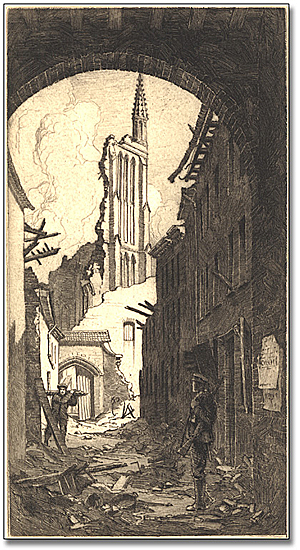
Click to see a larger image (163K)
Remains of St. Jacques, Ypres, May 4, 1916
Lieut. C. H. Barraud
Reference Code: C 334-1-2-0-16
Archives of Ontario, I0003114
The CWMF became a system of patronage with Beaverbrook turning to artists and illustrators to document Canadian subjects. Artists that participated were deemed to be the “King’s Guests” and were given honorary commissions in the Canadian Corps and salaries from the Canadian Government. Expenses were covered by the CWRO.
This eventually led to the hiring of more than one hundred artists
of many different nationalities and to the creation of hundreds
of oil paintings, sketches, etchings, sculptures and watercolours
depicting activities at the front as well as war related activities
at home.
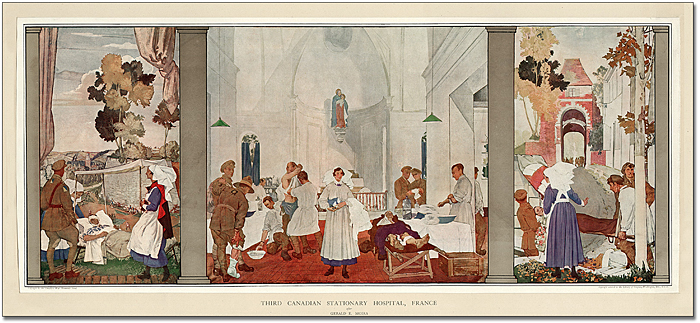
Click to see a larger image (175K)
Third Canadian Stationary Hospital, France, 1918
After Gerald E. Moira
Reference Code: C 334-2-0-0-6
Archives of Ontario, I0013653
Beaverbrook’s initial expectation was that the contracted artists would all be British. He soon realized that there were Canadian artists with significant talent and they were soon contributing to the CWMF’s collection. Though Canadian artists were in the minority they acquitted themselves well with many memorable images being created by artists such as A. Y. Jackson, David Milne, Maurice Cullen, F. H. Varley and Arthur Lismer.
Beaverbrook wanted eyewitness
records that were created spontaneously from sketches drawn on
the spot; he therefore encouraged his artists to roam the front
lines with freedom to go almost wherever they wanted. However,
much to his frustration, only 4 artists were allowed at the front
at any given time. This restriction remained in place until the
beginning of 1918 when the number was raised to six.
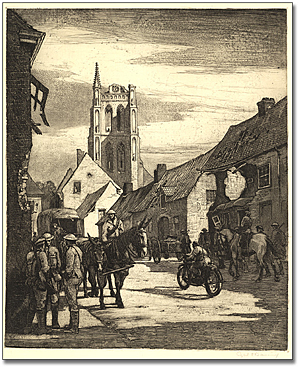
Click to see a larger image (263K)
The Road to Ypres through Vlamertinghe, [ca 1915]
Lieut. C.H. Barraud
Reference Code: C 334-1-2-0-20
Archives of Ontario, I0013633
This meant that many artists were
held back and had to reconcile themselves to sketching behind
the lines where they could be arrested as spies, bombed by German
aircraft or experience the German artillerie's interest in a particular
area they had chosen to sketch.
|
The Road to Ypres Through Vlamertinghe |
The creation of CWMF was
not the beginning of war artistry as many artists from the fighting
armies sketched for reconnaissance purposes or just to while away
the time. They designed honour rolls and war posters and donated
pictures to worthy causes.
However the CWMF did offer the opportunity for many artists to complete work in different mediums when to do so might have been considered an unsuitable way of spending time and resources.
|
The Barrier, Mont St. Eloy |
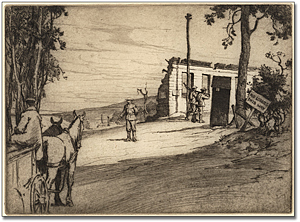
Click to see a larger image (230K)
The Barrier, Mont St. Eloy, near Vimy
Ridge, April 9, 1917
Lieut. C. H. Barraud
Reference Code: C 334-1-2-0-11
Archives of Ontario, I0003110
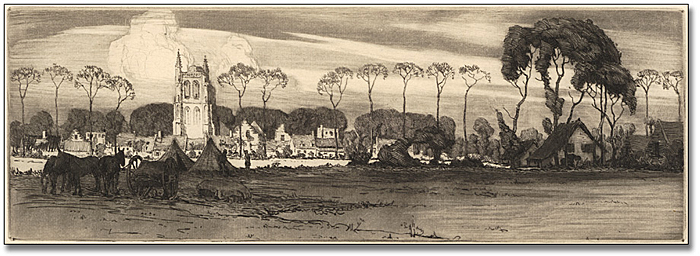
Click to see a larger image (231K)
Vlamertinghe, from the south west, August, 1917
Lieut. C. H. Barraud
Reference Code: C 334-1-2-0-15
Archives of Ontario, I0003102
|
Vlamertinghe |
War Artists from the First World War | The Canadian War Memorials Fund
The Burlington House Exhibit | The Battlegrounds | The Home Front
War Artists at Work | Resources